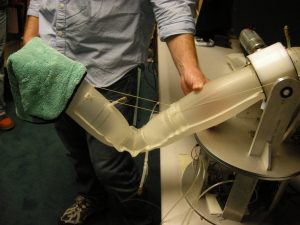Disney’s Big Hero 6 is set in an alternate reality that differs from our world in two major ways: the culture is a melding of American and Japanese influences, and the technological development is slightly more advanced than ours. Let’s take a look at some of that technology.

The most obvious example is Baymax, the medical robot designed by Tadashi Hamada, older brother of the lead character, Hiro. Baymax is based on research at Carnegie Mellon. “We had some really great conversations about robots in pop culture,” says director Don Hall. “And I learned that they were actually researching soft robotics, including this vinyl arm that was inflatable and non-threatening. It could do simple things like brush somebody’s teeth, but the possibilities were endless.”
Hiro follows in his brother’s footsteps, creating robots of his own. One of his inventions, the mentally controlled nanobots, earns him admission to the San Fransokyo Institute of Technology, where Tadashi is a student. Hiro’s anobots are tiny devices that can link together in myriad ways to create versatile machines with a variety of abilities. During the time that Big Hero 6 was in development, there have been advances in the area of cybernetics, including an interface to allow mental control of a prosthetic arm. Miniature micro-bots are being developed for a wide variety of applications including exploration of other planets.

After Hiro’s brother is killed, he joins up with a group of other students to investigate what appears to be the theft of his nanobots. Each of them adopts technological weapons; Hiro equips Baymax with an armored exoskeleton and jet-boots that allow him to fly, and creates an armored battle-suit for himself that magnetically connects to Baymax.
Go-Go Tamago’s gear uses magnetic-levitation (“maglev”) discs; linked to her wrists and ankles, the discs serve as roller skates, shields and throwing weapons. The friction-free rotation of the wheels allows her to move at tremendous speeds. Maglev technology is currently being used in high-speed railways; the trains float on a cushion of magnetic force, which is what gives them a smooth ride at speeds in excess of 300 miles per hour.
Neat freak martial artist Wasabi’s weapons are wrist-mounted plasma blades, which are based on developments growing out of plasma metal-cutting devices, first developed in the 1960s. One current application is in the medical field, where plasma scalpels are used for precise and bloodless surgery.

Fred, the laid-back sign-spinning slacker, adopts the super-identity of a fire-breathing kaiju, which means “strange beast” or “giant beast” in Japanese. Kaiju is a popular term for the Japanese giant monster movie genre. Fred pilots “Fredzilla” from a control center located behind one of the monster’s eyes. Believe it or not, some people are actually creating real-life giant pilot-controlled robots, called “Mechas.”
Honey Lemon kicks her chemistry knowledge into high gear by means of a clever handbag; it features a keypad on the outside arranged in the layout of the Periodic Table; she can punch in any combination, and the bag will produce spheres containing the formula she entered. These can be thrown like grenades to produce whatever effect is necessary, from a cloud of smoke to an explosion or any other chemical concoction.
 The skyline of San Fransokyo is dotted with what at first glance appear to be balloons. These high-flying objects are in fact tethered blimps containing wind turbines to generate electricity for the city. Aside from being a rather brilliant way to harvest the stronger winds found at high altitudes, the blimps are evocative of the fish kites seen in some Miyazaki films. They are also real.
The skyline of San Fransokyo is dotted with what at first glance appear to be balloons. These high-flying objects are in fact tethered blimps containing wind turbines to generate electricity for the city. Aside from being a rather brilliant way to harvest the stronger winds found at high altitudes, the blimps are evocative of the fish kites seen in some Miyazaki films. They are also real.
When Hiro creates the armor for Baymax, he uses a variety of fabrication machines including laser cutters and 3D printers, technologies currently in use in a great many diverse industries.
All told, the bleeding-edge technology in Big Hero 6 serves to simultaneously set the movie in the immediate future while also paradoxically grounding it in reality. There is no magic in the Big Hero 6 world, no fantastic super-powers to be seen; all of the fantastic action is based on real-world scientific advancements that are actually being developed right now, which makes the film seem very realistic even when giant mecha-monsters and nanobots are fighting it out in the middle of a city that doesn’t exist anywhere on our world.
Big Hero 6 opens November 7.





I love the mechanics!
I was blown away by all the science and machinery in this movie… It was all “totally wicked.” – Tricycle boy, The Incredibles.
They are called Microbots, not nanobots. I want/wanted to know if Go Go’s bike was/is real or close to becoming real.
Hey,
Thanks for putting together this post on The Technology of Big Hero 6.It is a great read. I particularly find your thoughts about plasma scalpels interesting.
Keep up these insightful posts.
Cheers!
Fredzilla’s outfit is a costume, not a mecha. It’s man sized, similar to a rubber foam padded mascot costume. His head is behind the third eye, the left and right eye are chest level.
The suit is equipped with flamethrowers in the faux mouth (lower chest level) and powerful jumping mechanisms in the legs and boots.
Love it keep it up you did a great job